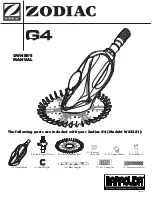
8. WINTERIZING THE POOL
In regions where freezing temperatures occur, it is common practice to close a pool during the winter months. This is
called winterizing.
All our pools were designed to stay outdoors during the winter. However, it is necessary to follow the following
directions to winterize your pool.
NEGLECTING TO FOLLOW THE WINTERIZING INSTRUCTIONS WILL VOID THE WARRANTY OF YOUR POOL.
A good winterization should only take a few hours and will make the spring opening of your pool easier.
As winter approaches, the temperature of the water cools, the addition of chemicals becomes less and less necessary.
However, it is necessary to periodically check the chemical parameters of the water in order to keep the water clean
and without deviations from the recommended values. Failure to respect these values could tarnish the pool liner
and reduce its life span. It is recommended to winterize the pool as late as possible (end September/beginning
October) when the temperature of the water is under 10 C (50 F). At this temperature, the proliferation of
contaminants is very slow.
Do not turn off the filtration system until the pool is completely closed. The early closing of the system could allow
the water in the pipes to freeze and break some of the elements of the filtration system.
8.1 INSPECTION
8.1.1 Before the annual closing of the pool, check the chemical parameters of the water (PH, alkalinity, chlorine…)
A water with unadjusted parameters will degrade the liner and could cause rust on the wall.
8.1.2 Check for any leaks in the liner. To make sure, sometime early in September, check that the water level does not
drop in a week period. If a drop in the water level is observed, there is a leak. Repair the holes in the liner using a repair
kit which can be found at your local dealer. Check for any leaks around the skimmer opening and water return. If a
leak is found, actions must be taken immediately to repair the problem. Check that the liner is still firmly attached to
the top of the wall.
8.1.3 Check the structure of the pool. If corrosion and scratches occur on the pool wall, you must be repair them by
using an anti-rust enameling product. Rub the rusted surface with a wire brush, apply the anti-rust product and
repaint the wall to match the repair to the color of the wall. Also check that the wall joint (joining the two ends of the
pool wall) is solid and that the screws are tight.
58.





































